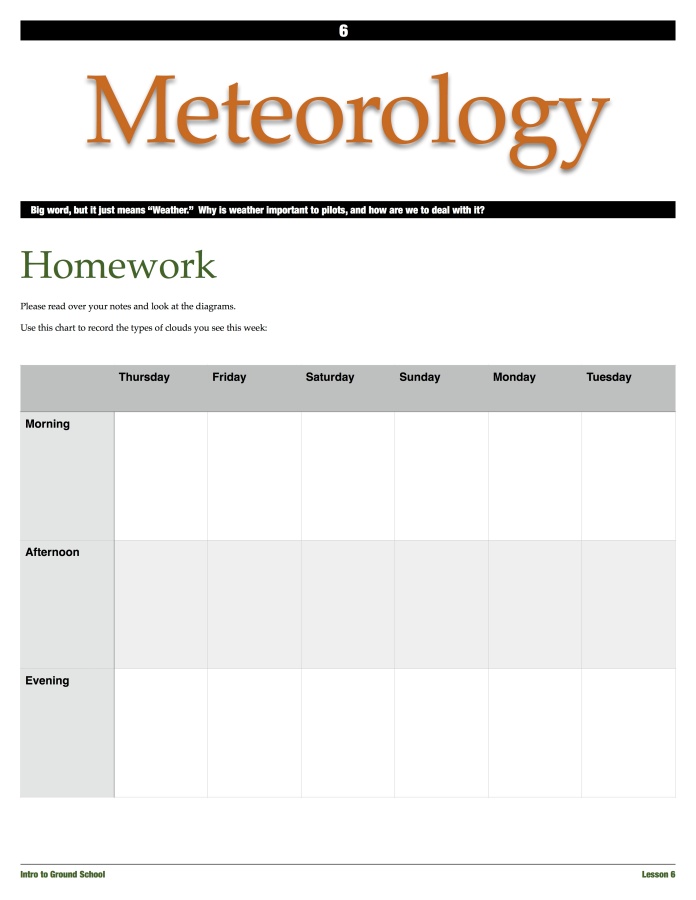This is a big topic, so it will take two class periods to cover.
Print a copy of each of the following for each student:
- Intro to Ground School: 6-7 Meteorology
- Cloud Chart
- Meteorology pages
And, if you are teaching a class, print the following for yourself: Meteorology Notes
DISCUSSION:
Quick intro: Weather on the ground vs. Weather in the air (flying)…
- On the ground, what do we care about when it comes to weather?
- When we’re flying, what do we care about?
- VFR:
- Visibility
- Clouds (remain clear of them!)
- Icing
- Wind
- Runway surface
- Pressure
- IFR:
- Visibility (only for T/O & Landing)
- Clouds (stormy or lenticular)
- Icing (at the surface or sustained)
- Wind (depends on plane)
- Runway surface
- Pressure
- VFR:
ATMOSPHERE
*** Diagrams***
- Atmospheric pressure: What is it? (caused by weight of air above you)
- High Pressure (above 29.92): Associated with “good weather”
- Stable air
- Cool, dense, dry air
- Increased performance
- ** Look out for fog, decreased visibility, icing **
- Low Pressure (below 29.92): Associated with “bad weather”
- Unstable air
- Warm updrafts
- Decreased performance
- Humidity
WHAT CREATES WEATHER?
- MOVING AIR
- MOISTURE
WHAT MAKES AIR MOVE?
- Changes in temperature
- ** Diagram: Sun, Earth, 45% absorbed, 55% reflected**
- WHAT AFFECTS AMOUNT OF TEMPERATURE CHANGE?
- Day/Night
- Latitude
- Water/Land
- City/Rural (dirt, concrete, glass)
- Season
- Altitude
- WIND
- A change in temperature leads to a change in pressure
- A never-ending attempt to produce equilibrium = WIND!
- TRANSPORTS WATER VAPOR
- SPREADS FOG, CLOUDS, PRECIPITATION
WARM AIR (heated surface):
- Expands and rises
- Becomes lighter
- Becomes less dense
COOL AIR:
- Compresses and sinks
- Becomes heavier
- Becomes more dense
Think of oil and water:
- Warm air wants to rise to the top because it’s less dense (like oil)
- Cool air wants to sink to the bottom because it’s more dense (like water)
** Moving air diagrams **
- Rising air is conducive to cloudiness & precipitation
- Descending air dissipates clouds
STABLE vs. UNSTABLE air
- Stratiform: Strata: Sheet-like, horizontal
- Cumuliform: Cumulus: Heap
CLOUDS
- Cirrus
- Usually indicates weather in a couple of days
- Cumulus
- Bumpy flight
- Might get wet
- Gray cumulus
- Precipitation
- Stratus
- May be visibility problems
- May stick around for a while
- Smooth flight
- Icing risk!
ICING
- Rime
- Clear
- Mixed
THUNDERSTORMS
- Cumulus
- Mature
- Dissipating
**PAGE 111! **

